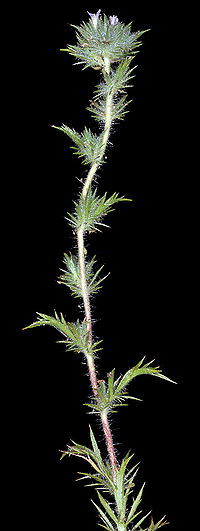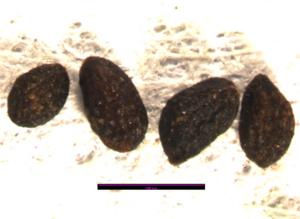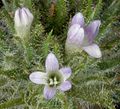Difference between revisions of "Navarretia squarrosa"
(→Description) |
(→Bloom Period) |
||
| (25 intermediate revisions by 4 users not shown) | |||
| Line 1: | Line 1: | ||
| − | + | * Scientific Name: ''Navarretia'' ''squarrosa'' | |
| − | Synonyms: Gilia squarrosa | + | * Family: Polemoniaceae |
| + | * Common Names: skunkweed | ||
| + | * Synonyms/Misapplications: ''Gilia'' ''squarrosa'' | ||
| + | * Codon: NAVSQU | ||
| + | ---- | ||
| + | [[File:NASQ whole.jpg|200px|thumb|''Navarretia squarrosa'' <br> Photo by Gerry D. Carr, also featured on Main Page.]] | ||
| − | + | ===Taxonomy=== | |
| + | {{Taxobox | ||
| + | | image = | ||
| + | | image_caption = | ||
| + | | name = | ||
| + | | regnum = [[Plant]]ae | ||
| + | | subregnum = Viridiplantae | ||
| + | | phylum = Tracheophyta | ||
| + | | subphylum= Spermatophytina | ||
| + | | classis = Magnoliopsida | ||
| + | | subclassis = Asteranae | ||
| + | | ordo = Ericales | ||
| + | | familia = Polemoniaceae | ||
| + | | genus = ''Navarretia'' Ruiz & Pav. | ||
| + | | species = ''''' Navarretia squarrosa''''' (Eschsch.) Hook. & Arn. | ||
| + | | synonyms = *''Gilia squarrosa'' (Eschsch.) Hook. & Arn. | ||
| + | }} | ||
| + | <ref>Integrated Taxonomic Information System. Retrieved from https://www.itis.gov/servlet/SingleRpt/SingleRpt?search_topic=TSN&search_value=31320#null</ref> | ||
| − | == | + | ===Description=== |
| − | + | Annual tap-rooted herb, glandular-hairy and skunk-smelling. Erect, simple, sometimes moderately branched. | |
| − | + | ||
| − | + | ||
| − | + | ||
| − | + | ||
| − | + | ||
| − | + | ||
| − | + | ||
| − | + | ||
| − | + | ||
| − | + | Leaves 1-2 times pinnate, spiky and stiff, the terminal segment not much longer than the other lobes, like in some other ''Navarretia'' species. | |
| − | + | ||
| − | + | Sessile flowers in terminal densely bracteate heads. Corollas pale to deep blue, 5-lobed. Stamens attached to corolla, inserted. Braces within inflorescences have bases with thin, membranous margins. | |
| − | ==Bloom Period== | + | Fruits are 3-locular capsules, each with usually 8 or more, sometimes as few as 6, seeds within, which is unique in area in this genus. Seeds become sticky when moistened.<ref>Klinkenberg, Brian. (Editor) 2020. ''E-Flora BC: Electronic'' |
| + | Atlas of the Plants of British Columbia'' [eflora.bc.ca]. Lab for Advanced'' | ||
| + | Spatial Analysis, Department of Geography, University of British Columbia, | ||
| + | Vancouver. [Accessed:2020-05-09]</ref><ref name=":1">Hitchcock, C. L., Cronquist, A., Giblin, D., & Legler, | ||
| + | B. et al. (2018). ''Flora of the Pacific Northwest: an illustrated manual''. | ||
| + | Seattle: University of Washington Press.</ref> | ||
| + | ===Bloom Period=== | ||
| + | June - September<ref name=":0">WTU Herbarium, Burke Museum, | ||
| + | & University of Washington. Retrieved from <nowiki>https://biology.burke.washington.edu/herbarium/imagecollection/taxon.php?Taxon=Navarretia%20squarrosa</nowiki></ref> | ||
| − | ==Distribution== West of the Cascades, from southern Vancouver Island, British Columbia, to California. | + | ===Distribution=== |
| − | + | West of the Cascades, from southern Vancouver Island, British Columbia, to California.<ref name=":0" /> | |
| − | ==Habitat== | + | ===Habitat=== |
| − | Open places | + | Open, wet places at low elevation.<ref name=":1" /> |
| − | + | ===Uses=== | |
| − | + | According to M. Sweet, ''Navarretia squarrosa'' has an edible seed when it is parched, ground into a powder and eaten dry.<ref>Sweet, M. (1998). ''Common edible & useful plants of the West''. Naturegraph Publishers.</ref> | |
| − | + | ||
| − | ==Uses | + | |
| − | + | ||
| − | + | ||
| − | + | ||
| − | + | ||
| − | + | ||
| − | + | ||
| − | ''' | + | |
| + | ===Seed=== | ||
| + | [[File:NASQ seed.png|thumb|right|300px|''Navarretia squarrosa'' <br> Photo Credit Lisa Hintz]] | ||
'''Seed sample from:''' 2011 | '''Seed sample from:''' 2011 | ||
| Line 58: | Line 71: | ||
'''Longitudinal Cross Section:''' elliptical [[File:NASQ long.png]] | '''Longitudinal Cross Section:''' elliptical [[File:NASQ long.png]] | ||
| + | |||
| + | {{Basics}} | ||
| + | |||
| + | ===Photo Gallery=== | ||
| + | <gallery> | ||
| + | File:NASQ seed.png|Seeds, photo by Lisa Hintz | ||
| + | File:NAVSQU1.png|courtesy of CNLM | ||
| + | File:NAVSQU2.jpg|Photo by G. D. Carr, 2006 | ||
| + | </gallery><gallery> | ||
| + | |||
| + | </gallery> | ||
| + | |||
| + | ===References=== | ||
| + | <references /> | ||
Latest revision as of 22:12, 20 March 2021
- Scientific Name: Navarretia squarrosa
- Family: Polemoniaceae
- Common Names: skunkweed
- Synonyms/Misapplications: Gilia squarrosa
- Codon: NAVSQU
Contents
Taxonomy
| Scientific classification | |
|---|---|
| Kingdom: | Plantae |
| Subkingdom: | Viridiplantae |
| Phylum: | Tracheophyta |
| Subphylum: | Spermatophytina |
| Class: | Magnoliopsida |
| Subclass: | Asteranae |
| Order: | Ericales |
| Family: | Polemoniaceae |
| Genus: | Navarretia Ruiz & Pav. |
| Species: | Navarretia squarrosa (Eschsch.) Hook. & Arn. |
| Synonyms | |
| |
Description
Annual tap-rooted herb, glandular-hairy and skunk-smelling. Erect, simple, sometimes moderately branched.
Leaves 1-2 times pinnate, spiky and stiff, the terminal segment not much longer than the other lobes, like in some other Navarretia species.
Sessile flowers in terminal densely bracteate heads. Corollas pale to deep blue, 5-lobed. Stamens attached to corolla, inserted. Braces within inflorescences have bases with thin, membranous margins.
Fruits are 3-locular capsules, each with usually 8 or more, sometimes as few as 6, seeds within, which is unique in area in this genus. Seeds become sticky when moistened.[2][3]
Bloom Period
June - September[4]
Distribution
West of the Cascades, from southern Vancouver Island, British Columbia, to California.[4]
Habitat
Open, wet places at low elevation.[3]
Uses
According to M. Sweet, Navarretia squarrosa has an edible seed when it is parched, ground into a powder and eaten dry.[5]
Seed
Seed sample from: 2011
Average Measurement: 0.9 x 0.6 x 0.5
Measurement Range: L: 0.75 – 1.1, W: 0.5 – 0.75, D: 0.4 – 0.5
Features
Shape: Seeds tapered to almost pointed at hilum ends. Body of seeds sometimes not completely filled out – some concave dents. Hilum is pinched looking in some.
Color: Seeds reddish brown, hilum usually slightly lighter in color, but not very conspicuous.
Surface: Seeds covered in wrinkly pitted pattern. About 30 – 40 medium sized pits visible on one seed face. Seeds slightly rough looking, and somewhat lustrous.
Latitudinal Cross Section: elliptical 
Longitudinal Cross Section: elliptical ![]()
Basic Explanations and Assumptions:
The dimensions for the seeds are length x width x depth. The location of the hilum is used as the base of the seed, and the length is measured from hilum to the opposite apex. Where a style is present, the length is measured from the hilum to the bottom of the style. Width is measured at a right angle to the length at the widest part. Depth is measured at a right angle to the intersection of height and width lines.
Measurements included are the mean average for each measurement of ten separate seeds.
All measurements in millimeters unless otherwise noted.
Photo Gallery
References
- ↑ Integrated Taxonomic Information System. Retrieved from https://www.itis.gov/servlet/SingleRpt/SingleRpt?search_topic=TSN&search_value=31320#null
- ↑ Klinkenberg, Brian. (Editor) 2020. E-Flora BC: Electronic Atlas of the Plants of British Columbia [eflora.bc.ca]. Lab for Advanced Spatial Analysis, Department of Geography, University of British Columbia, Vancouver. [Accessed:2020-05-09]
- ↑ 3.0 3.1 Hitchcock, C. L., Cronquist, A., Giblin, D., & Legler, B. et al. (2018). Flora of the Pacific Northwest: an illustrated manual. Seattle: University of Washington Press.
- ↑ 4.0 4.1 WTU Herbarium, Burke Museum, & University of Washington. Retrieved from https://biology.burke.washington.edu/herbarium/imagecollection/taxon.php?Taxon=Navarretia%20squarrosa
- ↑ Sweet, M. (1998). Common edible & useful plants of the West. Naturegraph Publishers.





